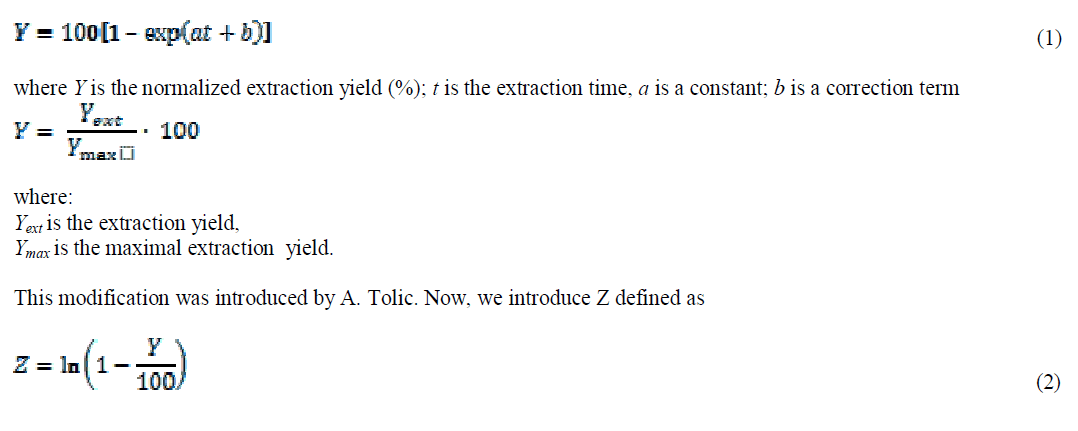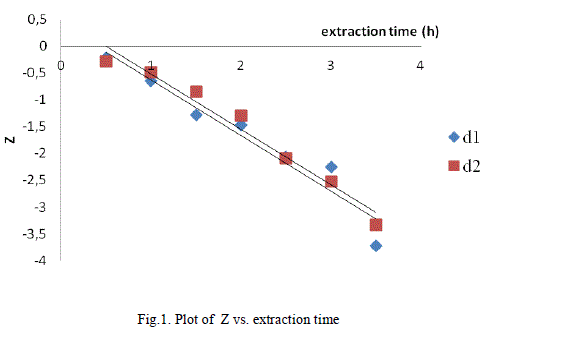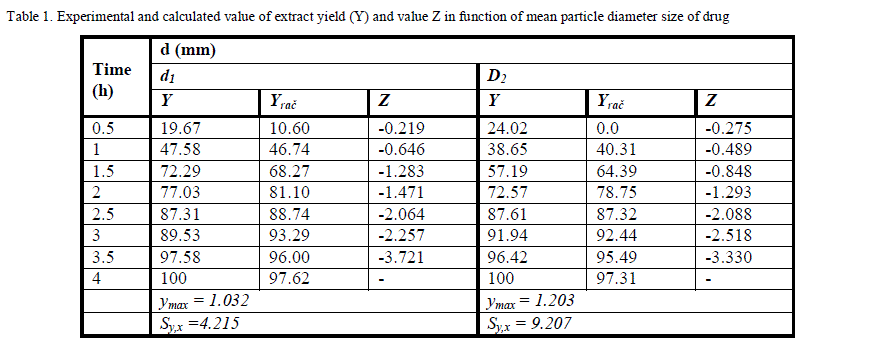ISSN ONLINE(2319-8753)PRINT(2347-6710)
ISSN ONLINE(2319-8753)PRINT(2347-6710)
Sabina Begić1, Vladan Mićić2, Zoran Petrović2 and Pero Dugić3
|
| Related article at Pubmed, Scholar Google |
Visit for more related articles at International Journal of Innovative Research in Science, Engineering and Technology
The Hyssop officinalis L. was extracted using supercritical carbon – dioxide (SFE – CO2) as extractant. Extraction was carried out in the two steps: the first one being carried out at 100 bar and 40ºC in time 4 h for the mean particle size 0.49 mm (extract A), and the second was the extraction of the hyssop sample at same conditions (pressure, temperature and time) for the mean particle size 0.13 mm (extract B). The supercritical fluid extraction (SFE) with carbon dioxide was carried out using a laboratory scale high pressure extraction plant - HPEP (Nova Swiss, Effretikon, Switzerland). Separator conditions were 15 bar and 25 ºC. Extraction kinetics of the system hyssop – SFE – CO2 was investigation. Mathematical modeling using Modified Reverchon - Sesti Osseo equation has been performed on Hyssop officinalis L. With modified equation fitted results was well.
Keywords |
| Hyssop, Supercritical extraction, Modelling, Carbon – dioxide. |
INTRODUCTION |
| With increasing public interest in herbal medicine and natural products, the conventional methods such as hydrodistillation and solvent extraction were found unsatisfactory. Conventionally, the essential oils of the aromatic herbs have been isolated using hydro-distillation and/or solvent extraction. However, low yield, loss of volatile compounds, long extraction times, toxic solvent residue, degradation of unsaturated compounds and production of undesirable off - flavours (due to heat) are involved in using such technique. To improve efficiency and selectivity of the extraction, alternative extraction techniques as supercritical extraction started to be developed. |
| Supercritical extraction is not widely used yet, but as new technologies are coming there are more and more view points that could justify it, as high purity, residual solvent content and environment protection [1], [2], [3]. |
| As an alternative approach, supercritical fluid extraction (SFE) has received increasing attention in the extraction of essential oils. This is due to fact that the supercritical fluids can provide improved mass-transfer rates and the operation can easily be manipulated by changing the pressure and/or temperature of the system. Also by optimizing these parameters, certain compounds can be selectively isolated from the drug. Carbon dioxide in its supercritical state has been used in many SFE applications [4], [5], [6]. |
| Carbon dioxide is the most commonly used supercritical fluid, due primarily to its low critical parameters (31.1°C, 73.8 bar), low cost and non-toxicity. Supercritical carbon dioxide (SCCO2) has found applications in the extraction of flavors and fragrances from their natural sources and as a result many studies have been published using this environmentally friendly extraction method. The extraction of coriander seed [7], chamomile [8], Thymbra spicata [9] and Carom copticum [10] are just a few of numerous studies reported in the literature using SCCO2 for the extraction of spices and medicinal herbs. Hyssop (Hyssopus officinalis), which is one of the most important pharmaceutical herbs, is extensively cultivated in central and south European counties such as Russia, Spain, France and Italy [11]. |
| Hyssop is used as a food flavour and also in sauce formulations. Hyssop oil possesses antifungal and anti-bacterial properties which are essential in such industries as canning, beverages and cosmetics. Food industry can always benefit from the new approaches leading to more hygienic ingredients such as food flavours. The essential oil of Hyssop from different origins has been reported using the traditional methods of extraction [12], [13], [14], [15], [16]. Further more, solvent extraction as well as other methods including SFE with single operational conditions, have been employed for determination of chemical composition of the essential oils of Hyssop [17], [18]. |
| The objectives of the present work were to investigate the effect of several SFE parameters (pressure, temperature, mean particle size) in the SCCO2 extraction of Bosnia hyssop. For the purposes of mathematical modeling there are numerous models dealing with SFE of essential oils and related products from plant material. Reverchon [19], classified existing models as: 1. Empirical, based on Langmuir –like empirical equation, 2. Models originated from heat transfer analogy, where SFE is treated as heat transfer phenomena, and 3. Models based on differential mass balance, where mass balance along a section of the extractor has been widely used to describe the behaviour of fixed beds during solid/liquid operations like adsorption/desorption, reaction, and extraction. |
| Hortacsu [2], classified available models as models, where extraction is defined as chemical reaction, and models where extraction is considered as physical phenomenon. The other approaches are Differential Mass Balance Models (i.e. Shrinking Core Model, Desorption –Dissolution –Diffusion Model) and other representations (like Models with Cellular Structure Representation, and Empirical Desorption Models). |
EXPERIMENTAL |
| Plant materials |
| For this experiments Hyssop. from Novi Grad, west part of Republica Srpska, state Bosnia and Herzegovina gathered 2007 was used. All extractions were performed using the Hyssop of the grinding degree d1 and d2 (mean particle radius d1 = 0.49 mm and d2 = 0.43 mm). |
| Chemicals |
| Commercial carbon dioxide (Tehnogas, Novi Sad, Serbia) were used. All other chemicals were of analytical reagent grade. |
| Supercritical fluid extraction |
| SFE by CO2 was carried out on a laboratory – scale high pressure extraction plant (HPEP, NOVA – Swiss, Effretikon, Switzerland). The main parts and characteristics (manufacturer specification) of the plant were as follows: a diaphragm – type compressor (up to 1000 bar), extractor with an internal volume of 200 mL (Pmax = 250bar), and maximum CO2 mass flow rate of approximately 5.7 kg/h. |
| The mass of hyssop in extractor was 60g at the investigated value of pressure (100 bar) and temperature (40ºC), the CO2 flow rate was 97.72 dm3/h. Separator conditions were 15 bar and 25ºC. |
EXPERIMENTAL RESULTS |
| For modeling of investigated hyssop – supercritical carbon dioxide extraction system in this paper, we used modified Reverchon - Sesti Osseo equation (1994). |
 |
 |
 |
CONCLUSION |
| Mathematical modeling using Modified Reverchon - Sesti Osseo equation has been performed for Hyssop. The calculated values of standard error of regression show that the modified equation in general has good fit for normalized yield of total extract. Also high value of correlation coefficient (r) shows that the given equation can be used for modeling hyssop –supercritical carbon dioxide extraction system. |
References |
|